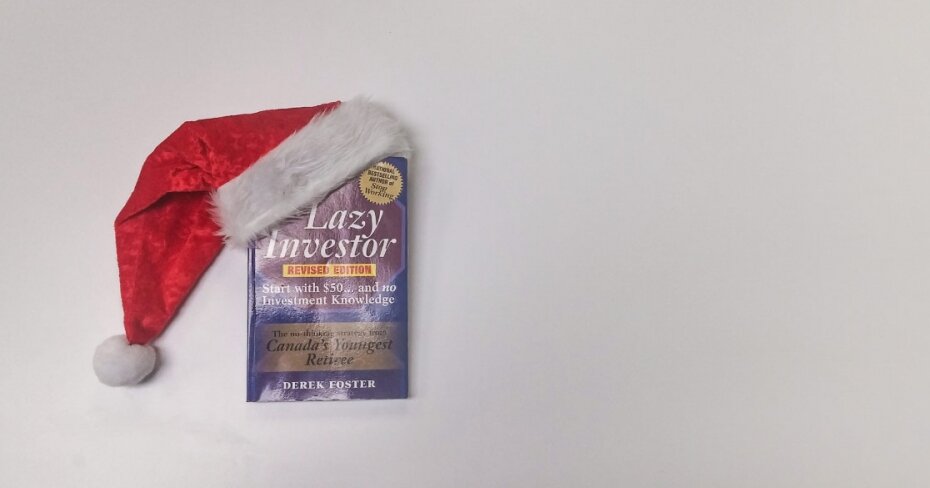LowestRates Reads: The Lazy Investor by Derek Foster
By: Dominic Licorish on December 29, 2016
Investing in stocks is probably one of the least understood areas of the financial world, and yet it's also one of the most recognizable. Like me, you've probably seen movies about Wall Street or read a few quotes from Warren Buffett, but when it comes to managing stocks, you’re absolutely clueless.
So when I saw The Lazy Investor on my parent’s bookshelf I thought to myself, “I want more money and I’m lazy as hell. Might as well give it a go.”
And so the LowestRates Reads personal finance review list gets one book longer. But unlike those previous books, which focused on financial literacy and basic finance tips, this one holds your hand and guides you to a better financial future.
Book title: The Lazy Investor
Year published: 2007, revised 2012 (reviewed copy)
Author name & bio: Derek Foster is a six-time bestselling author whose major claim to fame was that he became “Canada’s youngest retiree” at just 34 years old. The key to his success was his simple investment strategy and sensible approach to spending. He covers his investment approach in his six books. Aside from The Lazy Investor, his other works include:
STOP WORKING: Here’s How You Can!
Money for Nothing: And Your Stocks for FREE!
STOP WORKING TOO: You Still Can!
The Idiot Millionaire
The Worried Boomer: No Pension? Not Wealthy? Here’s YOUR Plan!
An avid traveler, Derek has made good use of his early retirement to spend time with his wife and five children. He is based out of Ottawa, Ont.
What’s this book all about
The Lazy Investor is a short, simple to read, step-by-step guide to getting into DIY investing for people who have no idea where to start. It was written at a time when many personal finance experts were opening the public’s eyes to the shortcomings of mutual funds. They sung the praises of the exchange-traded fund (ETF) as the best investment option for the average Joes and Janes of the country thanks to their lower expense ratios and transaction fees. Sure there might be a higher barrier of entry, but the idea is that a little bit of work today will translate into tens of thousands of dollars more in your pocket for the future. Foster’s approach is even more extreme, avoiding funds entirely and just buying shares in public companies directly.
By doing it all himself, he can keep fees to a minumum and his returns to a maximum. By his own account, doing this has allowed him to quit the hustle and bustle of a 9-to-5 life and live off investment income. He doesn’t promise that this is something that can be duplicated by everybody, but the book provides the knowledge one needs to set up a basic investment plan that they won’t have to keep a close eye on as it grows.
It’s the same basic idea being tossed around by sexy FinTech companies like Wealthsimple. Except, even Wealthsimple has fees that will rob your long-term yield of potentially thousands of dollars.
Apart from an explanation of his strategy, Foster has some interesting thoughts to share on wealth itself. What it really means, how to teach kids about money, and the classic: being frugal versus being cheap.
Who should read this book?
This book is probably one of the best ways to give yourself a crash course on investing. Foster does a fantastic job of injecting his admittedly dry subject matter with a bit of charisma and most importantly of all, keeping things concise and well-paced. You can fly through this whole book in a weekend or you can take it chapter by chapter.
After reading it, you’ll be familiar with many of the most important investment terms and concepts (Bear market? Bull market? DRiPs? All these answers and more in The Lazy Investor!). Because of that, it’s a good book for anyone 18 or older. Most people reading the book are bound to be a little bit older, but I personally wish I’d read this when I was 17 and just started working. If I’d followed this advice when I was 18, I’d be a so much closer to my financial goals than I am today.
This book is also for parents who are either thinking about long-term goals, such as retirement or supporting their kid’s education. Most importantly, it gives tips to parents for teaching their kids about money, and investments at an early age.
3 biggest takeaways
1. The stock market isn’t a game so don’t try to play it
Movies like The Wolf of Wall Street portray stock trading as absolute chaos. The brokers don’t really know (or care) if the stocks you’re buying do well or not; they’re getting fat off those commissions. There’s a good point there underneath the Hollywood exaggeration, and it’s one Foster uses to form the basis of this book. It’s that trying to play the market is useless. Instead, pick stocks with a history of good performance, set your budget, and buy consistently. This is called dollar-cost averaging. Over time, you’ll make more money than you put in, and at the end of the day, that’s what investing is about.
2. Build wealth one DRiP and SPP at a time
The cornerstone of Foster’s investment strategy is to avoid as many fees as possible so you have more cash working for you. One of the ways to do this is to make use of Dividend Reinvestment Plans (DRiP). As the name implies, these plans automatically reinvest the dividends paid out by the companies you hold shares in. The big benefit of this is, over time, you’ll basically get what feel like free shares, which translates into free money when selling.
Foster also talks about Share Purchase Plans (SPP) which help optimize your investing in a similar way. Enrolling in a company’s SPP will let you buy more shares directly from them without any brokerage fees. These plans are typically offered only to existing shareholders, however, and there are only some companies that offer both DRiPs and SPPs. Being aware, however, of what those terms mean is a huge part of understanding the investing strategy in the book.
3. Buy the same stocks as the idiot millionaire himself
Maybe the biggest takeaway of the whole book is that he included what his actual portfolio was at the time. He also makes sure to provide real world examples of stocks he recommends, and similar alternatives as he explains his investment strategy. So if you thought you’d need to spend hours researching which companies to invest in — think again. The book is a few years old, so some of his picks might not be the smartest to go for in 2017, but his core message still works — opt for big, stable companies that are likely to be around in the long run.
Favourite quote from book
“A quick look at the richest people reveal that they have most of their wealth tied up in only one country. In fact, their money is usually invested in a single company — usually their own. If the mutual fund route is the way to go, why do the richest people invest the majority of their money in direct ownership of a company in their home country?”


